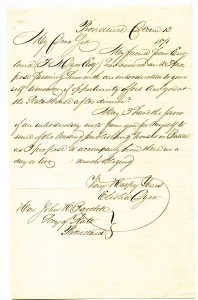(The following post is contributed by Ramon Cartwright, a RISD graduate and one of our fantastic volunteers. Ramon recently finished processing a collection of over 800 important and wide-ranging manuscript items. Items from the collection have been mentioned on this blog before (here, here, here and here, for instance) but this is the first time the collection has been fully listed online. Upcoming posts will highlight other items from the collection and conservation efforts to preserve it.)
The processing of the Daniel Berkeley Updike Autograph Collection has been completed. Although there is evidence that the collection was initially comprised of New England names, the collection has now grown to reflect a more diverse grouping. A selection of the material, much of which had been culled from the correspondence and papers of Wilkins Updike, includes the names of men involved in politics. Eleven presidential signatures are included in the collection. Also included within the miscellany is a letter from Edgar Rice Burroughs, a poetic excerpt from Sarah Helen Whitman, and a series of fervid letters from a Union soldier to his parents.
During the processing of the Daniel Berkeley Updike Autograph Collection I encountered a 12 page manuscript by Agnes Repplier (1855-1950), titled “What Pessimism Is.” Repplier was a Philadelphia born essayist, biographer and occasional poet published regularly within the pages of The Atlantic Monthly. Her numerous essays were also published in Life, Harper’s, Monthly Magazine, The New Republic, McClure’s, and The Yale Review. “What Pessimism Is” expands upon and clarifies Repplier’s criticism of the poetry of Robert Browning. In an earlier analysis, also published in The Atlantic Monthly, Repplier had classified Browning’s poetry as “of the pessimistic order.” A controversy ensued. Browning enthusiasts found fault with the criticism and surmised that Repplier had failed to grasp Browning’s meaning. “What Pessimism Is,” offers her defense of the initial appraisal using examples of the poet’s works. The essay was published in The Atlantic Monthly Vol. LXII, 1888. Below the reader will find the first four pages of the manuscript. The pages illuminate the background to the article’s origin. Her wit and erudition, for which she had been known, are evinced in these first few pages.




Also included in the Updike Autograph Collection is a leaf from Henry David Thoreau’s essay “October, or Autumnal Tints.” Originally published in the October 1862 Atlantic Monthly, the essay offers Thoreau’s extended meditation on the changing color of New England autumnal foliage. Among the tints that Thoreau focuses upon, the reader will find poetic descriptions of Sarsaparilla, Pokeweed, Red Maple, the Elm, Scarlet Oak, and more. The brief explication on each tint is presented in the order in which the brightest colors are displayed. The manuscript focuses on ripeness, as it is evinced in the brighter hue flowers assume prior to falling. The extract includes passages that were later revised prior to publication. The leaf is float mounted on an 8 3/4 x 10 1/4 sheet of paper.

































